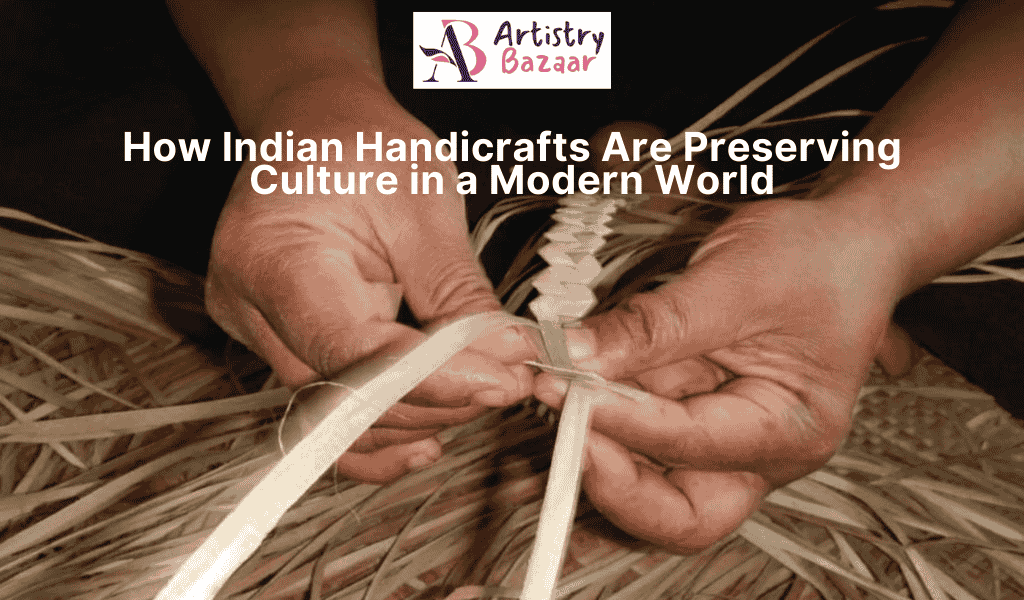“India lives in its villages,” Mahatma Gandhi once said—and in those villages, culture often takes shape through hands that weave, carve, paint, and mold. From the woodcraft of Saharanpur to the terracotta of Bengal, Indian handicrafts are not just decorative pieces; they are timeless stories woven with threads of tradition. In a world racing toward technology, e-commerce, and machine-made products, these crafts stand as living reminders of identity, heritage, and artistry. Surprisingly, while the modern world poses challenges, it has also opened new doors for these crafts to thrive.
This is the story of how Indian handicraft products are not only surviving but also preserving the essence of India’s culture in today’s globalized world.
1. Handicrafts as Living History
Every handicraft is a page out of India’s cultural diary. When you hold a piece of blue pottery from Rajasthan, you aren’t just looking at art—you are holding centuries of tradition, passed down from one generation to another.
- Textiles like Ikat, Banarasi, and Pashmina showcase India’s regional diversity and craftsmanship.
- Wood carving, metalwork, and stone inlay preserve traditional skills that might have otherwise been lost.
- Each piece reflects the values, rituals, and lifestyle of the community it originates from.
Thus, handicrafts become more than just “products”; they transform into tangible pieces of cultural storytelling.
2. Blending Tradition with Modern Utility
One reason handicrafts are relevant today is their ability to adapt. Artisans are not just replicating old designs—they are reimagining them for modern homes and urban lifestyles. For example:
- Traditional lamps are now designed with modern aesthetics to fit into contemporary living rooms.
- Decorative items for the home, like hand-painted vases or jute baskets, are crafted to suit both rustic and modern interiors.
- Even intricate embroidery has moved beyond garments to adorn cushion covers, wall hangings, and handbags.
By staying functional while carrying a cultural soul, handicrafts seamlessly weave heritage into daily living.
3. Sustainability: A Cultural Value Reborn
In a time when mass production and synthetic goods dominate the market, handicrafts remind us of sustainable living.
- Most handicrafts are made from natural, eco-friendly materials like clay, bamboo, jute, and wood.
- They encourage recycling—think of patchwork quilts made from leftover fabric.
- Handcrafted items are durable, reducing the “throwaway culture” promoted by factory-made goods.
The world is finally recognizing that traditional artisans were the original champions of sustainability, centuries before it became a global buzzword.
4. A Cultural Touch in Home Interiors
Modern homes today are no longer just about style—they are about creating a soulful atmosphere. And that’s where handicrafts find their true place.
- Home Decor Statues like brass Ganesha, marble Buddha, or tribal figurines instantly add cultural depth to a room.
- Bath Decor items like handwoven towels, terracotta soap dishes, or bamboo baskets combine functionality with tradition.
- Handcrafted lamps, rugs, and wall hangings infuse personality into spaces that often feel mechanical with store-bought furniture.
When placed thoughtfully, handicrafts create homes that are not just “houses” but cultural sanctuaries.
5. Empowering Artisans, Empowering Culture
Behind every handmade product lies an artisan whose livelihood depends on preserving these skills. When people buy handicrafts, they aren’t just purchasing art—they are fueling cultural continuity.
- India has over 7 million artisans, many of whom belong to marginalized communities.
- Supporting their work prevents traditional skills from disappearing in the shadow of industrialization.
- Fair trade initiatives and e-commerce platforms now connect artisans directly to global markets, ensuring better pay and recognition.
Thus, handicrafts don’t just decorate homes—they empower families, sustain villages, and preserve cultural identity.
6. Festivals and Rituals: Where Crafts Come Alive
India’s festivals are incomplete without handicrafts. Be it the earthen diyas during Diwali, colorful kites during Makar Sankranti, or intricate rangoli designs at weddings, crafts continue to play an integral role in cultural celebrations.
These aren’t just seasonal products—they symbolize traditions that keep cultural practices alive in the modern era. Even urban households, surrounded by modern conveniences, turn to these handmade pieces when it’s time to celebrate.
7. Global Recognition and Cultural Exchange
Indian handicrafts have found admirers worldwide. From New York penthouses displaying Kashmiri carpets to Parisian homes adorned with Jaipur blue pottery, these crafts cross borders while carrying Indian culture with them.
- International exhibitions showcase regional crafts to global buyers.
- Celebrities and designers increasingly use Indian textiles and artifacts in their collections.
- Tourism plays a big role, with travelers seeking souvenirs like miniature paintings or handwoven scarves.
This cultural export ensures that India’s heritage doesn’t remain confined within its borders but becomes a part of the world’s artistic identity.
8. Digital Revolution: Taking Crafts Online
Traditionally, artisans relied on local markets or exhibitions to sell their products. But today, the internet has opened doors they never imagined.
- Online platforms allow artisans to sell it to customers sitting thousands of miles away.
- Social media helps them showcase not just their products, but also the story and effort behind each creation.
- E-commerce ensures fairer trade by reducing middlemen, allowing artisans to get better value for their work.
This digital empowerment is giving traditional crafts a modern stage, ensuring their relevance in the fast-changing global market.
9. Challenges That Remain
Despite all the recognition, handicrafts face serious challenges:
- Mass production and cheap imitations threaten the uniqueness of handmade goods.
- Younger generations often move away from traditional crafts due to low income and lack of recognition.
- Many artisans struggle with limited access to resources, training, and markets.
Preserving these crafts requires not just consumer interest but also government policies, educational programs, and sustainable initiatives that keep artisans motivated and financially secure.
10. The Emotional Connection
Finally, what makes handicrafts so special is the emotional bond they create. Unlike machine-made products, handmade crafts carry imperfections that make them unique. Owning them means owning something no one else has—a small but powerful piece of heritage.
When a family places Home Decor Statues in their living room, it’s not just decoration; it’s about inviting stories, values, and blessings into their space. When someone chooses a handwoven basket for Bath Decor, they bring not just functionality but also tradition into their routine. This emotional depth is why handicrafts will never lose their place, no matter how modern the world becomes.
In Short
Indian handicrafts are far more than objects of beauty—they are bridges connecting the past to the present, tradition to modernity, and artisans to the world. They carry within them the resilience of cultures that refused to vanish, adapting just enough to stay relevant while holding tight to their roots. Also, if you’re searching for a platform that sells multicategory handmade products in bulk, visit ArtistryBazaar. We offer free worldwide shipping, door-to-door delivery, flexible payments (just 30% upfront and 70% before dispatch), and an extra up to 10% off with our promo code.

